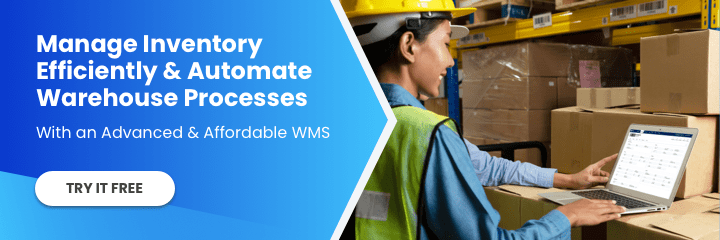Are you drowning in excess inventory, unsure what to do with it? If so, you’re not alone. Many businesses and warehouses face the challenge of excess stock, which can tie up valuable capital and space. But fear not! This article will share practical tips and tricks for turning excess inventory into revenue.
Click Here: Manage Inventory Effectively With This Advanced and Affordable WMS
Managing excess inventory is essential for maintaining a healthy cash flow and maximizing profits. By implementing effective strategies, you can clear out your surplus stock and generate additional revenue in the process.
Don’t let excess inventory weigh you down. Join us as we delve into practical solutions to transform your surplus stock into revenue-generating opportunities. Get ready to optimize your inventory management and boost your bottom line.
What is Excess Inventory?
Excess inventory refers to the surplus stock that a business holds beyond its immediate needs or expected demand. It can occur for various reasons, such as overestimating customer demand, changes in market trends, or production issues. Understanding why excess inventory happens is crucial for developing effective strategies to deal with it.

What Causes Excess Inventory?
One common cause of excess inventory is poor demand forecasting. If a business fails to predict customer demand accurately, it can lead to overstocking. Changes in market trends or unexpected events can also result in excess inventory. For example, if a product becomes outdated or the market experiences a sudden shift, businesses may find themselves with excess stock that is difficult to sell.
The Impact of Excess Inventory on Your Business
Excess inventory can have a significant impact on your business. It ties up valuable capital, increases storage costs, and can lead to obsolescence or spoilage. Moreover, it can hinder cash flow and prevent you from investing in other areas of your business. That’s why developing effective strategies to manage and sell your excess inventory is crucial.
Solutions for Managing Excess Inventory
Managing excess inventory requires a systematic approach to ensure that you can clear out surplus stock while maximizing revenue. Here are some proven solutions that can help you effectively tackle excess inventory:
1. Determine Which Products to Sell
When faced with excess inventory, it’s important to prioritize which products to sell first. Start by analyzing your inventory data to identify products with the highest carrying costs or those nearing expiration dates. Focusing on these items can prevent further financial losses and free up valuable storage space.
Consider product popularity, customer demand, and profitability when deciding which products to prioritize. You can also conduct market research to identify potential sales channels or target markets interested in your excess inventory.
2. Setting Prices for Excess Inventory
Setting the right prices is one of the first steps to turning your excess inventory into revenue. It’s crucial to strike a balance between recouping your costs and offering attractive deals to potential buyers. Here are some tips to help you determine the optimal pricing for your surplus stock:
- Research the market: Research similar products or competitors to understand the current market prices. This will show you how much you can reasonably charge for your excess inventory.
- Consider discounts: Offering discounts can effectively entice buyers and quickly sell off your surplus stock. Calculate the discount percentage based on your desired profit margin and adjust the prices accordingly.
- Bundle products: If you have multiple items that complement each other, consider bundling them at a discounted price. This helps you clear out inventory faster and adds value for the buyer.
Remember, when setting prices for excess inventory, it’s essential to balance attracting buyers and ensuring profitability.
3. Marketing Your Excess Inventory
Once you have determined the right prices for your excess inventory, it’s time to market it effectively. Here are some strategies to help you reach your target audience and generate interest in your surplus stock:
- Create a dedicated landing page: Design a landing page on your website specifically for your excess inventory. Highlight the discounted prices, bundle deals, and other incentives to attract potential buyers. Optimize the page for search engines to increase its visibility online.
- Leverage social media: Utilize social media platforms to promote your excess inventory. Share appealing visuals, product descriptions, and discounts to engage your followers and encourage them to spread the word.
- Email marketing campaigns: Tap into your existing customer base by sending targeted email campaigns. Segment your email list based on relevant criteria such as past purchases or preferences, and tailor your messaging to highlight the benefits of buying your excess inventory.
By implementing these marketing strategies, you can effectively reach your target audience and create demand for your surplus stock.
4. Tips for Selling Excess Inventory on E-Commerce Platforms
E-commerce platforms provide a vast marketplace to sell your excess inventory. To maximize your chances of success, consider the following tips when selling on these platforms:
- Optimize product listings: Create compelling product descriptions highlighting your excess inventory’s key features and benefits. Use high-quality images that showcase the product from different angles. Include relevant keywords in your listings to improve search visibility.
- Offer competitive shipping options: Free or discounted shipping is a great way to attract buyers. Research shipping rates and negotiate discounted rates with shipping providers to minimize your costs while still providing an attractive offer to customers.
Selling on e-commerce platforms can open up new avenues for selling excess inventory. By optimizing your product listings and leveraging advertising options, you can maximize your reach and potential revenue.
5. Negotiating with Suppliers to Prevent Excess Inventory
Prevention is always better than cure when it comes to excess inventory. By negotiating with your suppliers, you can minimize the risk of overstocking. Here’s how:
- Forecast demand accurately: Share your sales forecasts with suppliers to help them understand your expected demand. This allows them to adjust their production accordingly, reducing the chances of excess inventory.
- Flexible order quantities: Discuss flexible order quantities with your suppliers to ensure you can adjust your purchases based on market demand. This way, you can avoid excess inventory if sales do not meet expectations.
- Return agreements: Negotiate return agreements with your suppliers to establish a process for returning excess inventory. This can provide you with a safety net in case you overestimate demand.
By maintaining open communication and negotiating favorable terms with your suppliers, you can prevent excess inventory and maintain a healthy supply chain.

6. Warehouse Management Systems to Prevent Excess Inventory
An efficient warehouse management system prevents excess inventory and maintains a healthy stock level. Here are some key features to consider when choosing an inventory management system:
- Accurate demand forecasting: The system should have robust forecasting capabilities to help you predict customer demand accurately.
- Real-time inventory tracking: Ensure the system provides real-time visibility of your inventory levels, allowing you to make informed decisions.
- Automated reordering: Look for a system that can automatically generate purchase orders based on predefined inventory thresholds, streamlining the reordering process.
- Integration with sales channels: The system should seamlessly integrate with your e-commerce platforms or point-of-sale systems, enabling automatic updates of stock levels.
By implementing an effective warehouse management system, you can prevent excess inventory, optimize stock levels, and improve overall operational efficiency.
Conclusion
Excess inventory can be a significant challenge for businesses, but with the right strategies and tools, it can also become an opportunity to generate additional revenue. Understanding the causes of excess inventory and implementing effective management techniques can turn surplus stock into a valuable asset.
Prioritize products, set competitive prices, and leverage various marketing channels to sell your excess inventory efficiently. Explore e-commerce platforms and negotiate with suppliers to prevent future stockpiling. Finally, implement a warehouse management system to optimize stock levels and maintain a healthy cash flow.
With the tips and tricks in this article, you can optimize your inventory management and boost your bottom line. Take action today to transform your surplus stock into revenue-generating opportunities.
For more information about streamlining warehouse operations or the latest warehouse technologies trends, you can follow us on LinkedIn, YouTube, X, or Facebook. If you have other inquiries or suggestions, don’t hesitate to contact us here. We’ll be happy to hear from you.












